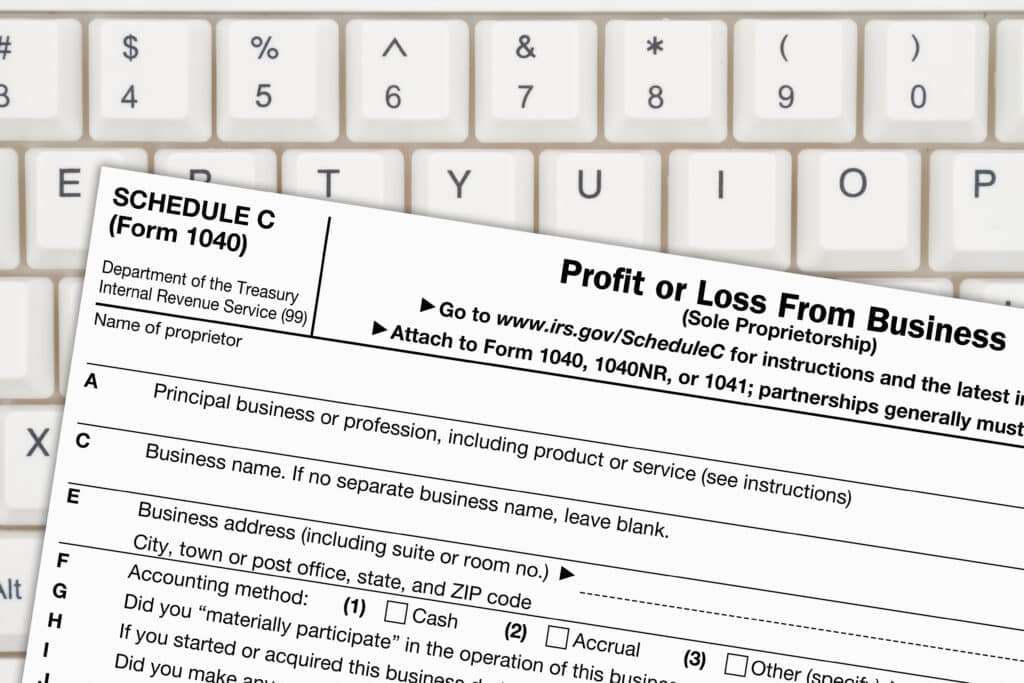How to Report Profit or Loss from Business with Schedule C for Expats

Running a business involves managing a packed schedule. Tax season adds to the workload with extra paperwork. If you’re among the ten percent of self-employed U.S. taxpayers, you might need to prepare a Schedule C form.
Schedule C, also known as Profit or Loss from Business, lets you report your business income and the expenses you incur to operate it. This form calculates your net income and loss for tax purposes.
But what kind of income and expenses must you report? Who needs to file the Schedule C form?
Keep reading to find answers to common questions and follow an easy step-by-step guide on completing the form.
A Breakdown of Reportable Items
The IRS requires that you report all revenue linked to your business operations during the tax year, regardless of whether you’ve been paid in cash, check, or credit card. These include the sales of products or services, commissions, fees, and any other forms of compensation. You must also include income reported on specific forms, such as Forms 1099-K, 1099-MISC, and 1099-NEC.
In addition to income, you must report expenses incurred in running your business. These include rent for office space, office supplies, marketing expenses, and business insurance premiums. You can also claim depreciation on business assets and deduct a portion of your home office expenses if you meet specific criteria.
Business-related travel expenses, including airfare, lodging, and meals, can also be reported. However, remember that meal deductions are limited. Generally, only 50% of the cost is deductible.
Finally, if you hire employees or independent contractors, their wages and fees are deductible business expenses.
Once you’ve listed all the items, deduct the total expenses from your gross income to find out your net profit. If this surpasses $400, you’re required to complete a Schedule SE to determine the tax owed on your net earnings from self-employment.
Who Must File the Schedule C Form
Schedule C is for you if you run a business as a sole proprietor or a single-member LLC.
This could include freelancers, consultants, landscapers, dog walkers, and anyone else who earns income through their own hustle. Regardless of the amount you earn, filing this form is mandatory.
In case you’re wondering, here are the key differences between sole proprietorship and single-member LLC:
A sole proprietorship represents the simplest form of business structure. You become a sole proprietor if you begin a business without forming an LLC or corporation. Here, you and your business are treated as one. This means that you will personally be liable for any debts or legal obligations incurred by your business.
A single-member LLC registers as a business entity owned by only one person. It works similarly to a sole proprietorship but provides liability protection to the owner.
How to Complete the Schedule C Form, Step by Step
Before you begin, gather all the information you need to complete the form. Include the 1099 forms provided by your clients, bank statements, invoices or receipts, and other financial records linked to your business income and expenses.
Step 1: Provide Business Information
Start by entering basic information, including your name and social security number. If your business has a name, make sure to indicate it along with its address and the employer identification number if applicable.
The form also requires a code to identify the type of business you have. You can select from the predetermined list of codes. If you don’t know which code to use, make your best guess. Don’t worry, the agency won’t penalize you for choosing the wrong one.
Step 2: Determine Cost of Goods
This refers to the cost of the materials and labor directly involved in making your products. You’ll only need to do this step if your business sells products. You can find this information in Part III of the form. Once calculated, enter the resulting amount on Line 4 under the income category.
Step 3: Calculate Your Gross Income
To get your total revenue, begin by entering your gross receipts or sales, including any returns or discounted merchandise, in line 1. Then, subtract returns and allowances, as well as the cost of goods sold, from your total gross sales. Finally, add any other listed income to that result.
Step 4: Deduct Business Expenses
Here, you list all the money you spent running your business. You can only deduct “ordinary and necessary” expenses, meaning they’re common for your industry and essential for your operations.
After totaling all your costs, subtract them from your gross income from line 7. Determine whether you have a net profit or loss. If it’s a loss, follow the instructions on line 32. Otherwise, enter the amount on your Schedule 1, line 3, and on Schedule SE, line 2.
Step 5: Enter Information on Your Vehicle
Complete the section if you are claiming car or truck expenses and don’t need to file Form 4562 for your business. You don’t need a company car to claim this deduction. If you use your personal car, you can deduct the miles driven for work-related purposes at an IRS standard rate. This could include customer visits and business meetings. Or, you can also opt to deduct actual expenses such as gas, oil, and repairs.
Step 6: List any ‘’Other’’ expenses
Complete this section to report any additional business expenses not covered in Part II of the form. Examples may include amortizing certain costs like pollution-control facilities, research, and intangibles such as goodwill. You can also list business start-up costs and Gulf Opportunity (GO) Zone clean-up costs here.
When to File Schedule C
You need to submit Schedule C and all other schedule forms along with your personal tax return, typically by April 15th. If you filed an extension, you have until October 15th to submit them.
Dealing with extra forms may feel like a lot, but it’s necessary for compliance. Schedule C helps you write off eligible expenses, which in turn lowers your taxable income.
Whether you’re a self-employed individual, freelancer, gig worker, or business owner who needs to file Schedule C or other tax forms but lacks the time or confidence to do so, let tax pros help.
Tax Samaritan’s team of tax professionals can offer expert advice and support tailored to your unique tax situation. Call 775-305-1040 for a free 15-minute, no-obligation consultation meeting.


